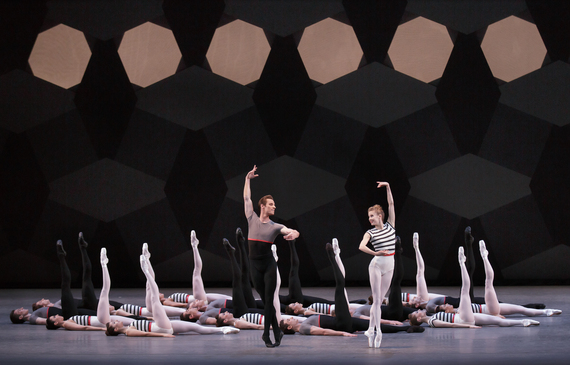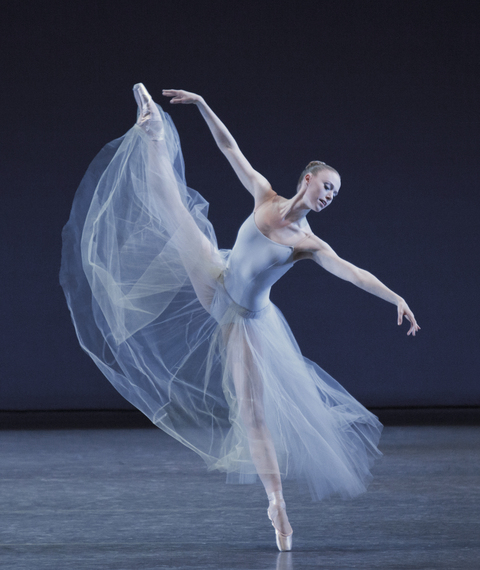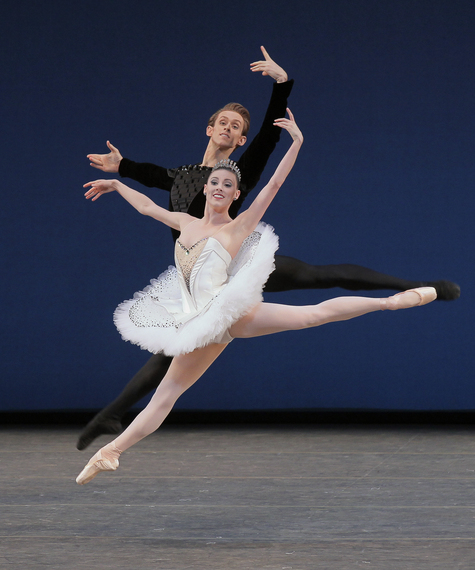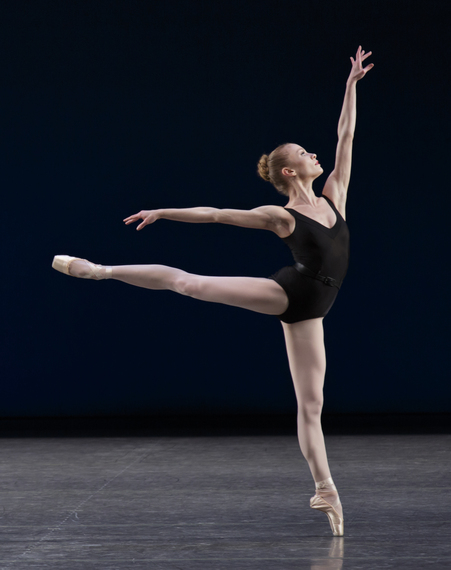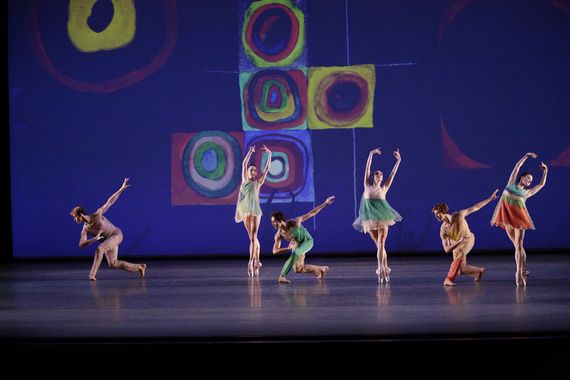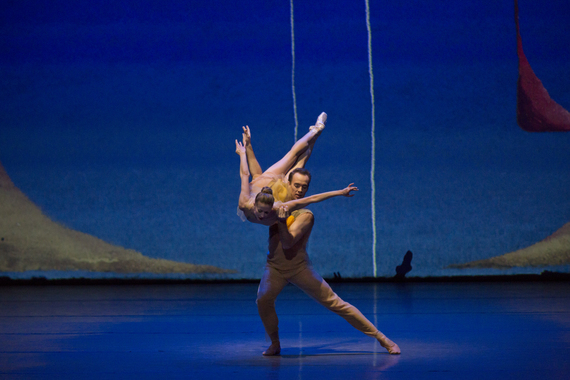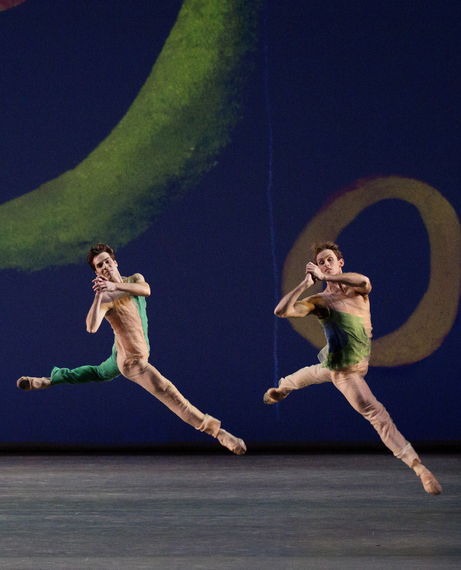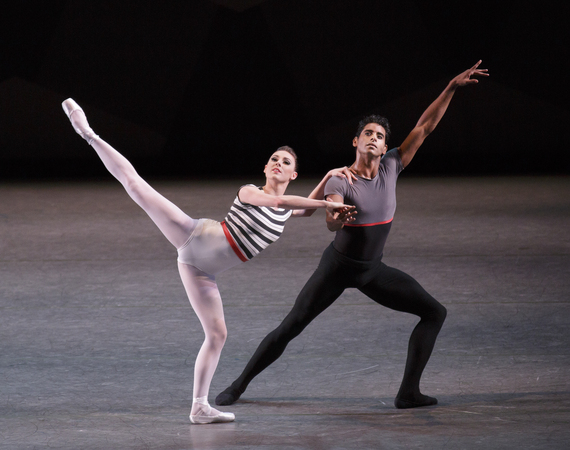Installed at the Kennedy Center this past weekend, New York City Ballet bowed to its glorious past and flaunted its protean present in two dazzling programs.
Ballet to the People had the accidental privilege of sitting next to very young people on both Saturday and Sunday matinées, whose laconic reactions neatly summed up her own.
On Saturday afternoon, the company that currently possesses the greatest repertoire in the world served up a Balanchine banquet of Tchaikovsky appetizer, Stravinsky main and Bizet dessert, with the tiny dynamo Clotilde Otranto firmly at the helm of the New York City Ballet Orchestra.
"Angels" announced the 7-year-old, as a chorus of nymphs in Serenade, draped in layers of cirrus cloud, languorously plucked stars from the night sky and with delicate hands traced a slow arc to brow, then heart. Led by the otherworldly Sara Mearns, the glamorous Ashly Isaacs and commanding Megan LeCrone, the corps gamboled wittily through a century of ballet history, from the famous arabesque hops of the Wilis in Giselle to the mad waltzing of Ginger Rogers and Fred Astaire, only to break our hearts in the final Elegy, as Mearns slowly ascended into the sky on the shoulders of nearly invisible men (who barely feature in this remarkable feminist paean from 1935), united in deep backbend with her earthbound handmaidens. They left not a dry eye in the house - though the interior mysteries of Serenade permit a slew of varying interpretations.
The company shone again in the exhilarating Symphony in C -- figuratively and literally, thanks to the heavy hand that sprinkled Swarovski crystals over tutus and velvet doublets (the 7-year-old suspected batteries hidden underneath the costumes.) The tempo was dialed down in comparison to the velocity with which City Ballet's cross-plaza rival, American Ballet Theatre, tears through the Bizet, yet electricity shot through the fusillade of precision footwork, jumps and endlessly spinning turns.
This architectural wonder was anchored by the gleeful Ashley Bouder in the opening movement, whose brilliant allegro technique and rock-solid balances underpin her mischievous phrasing, and the radiant Lauren King, who, together with the ebullient Taylor Stanley, captained the final caffeinated movement. In between, Tyler Angle's devotion could not ease the conspicuous nervousness of Maria Kowroski, who made beautiful lines in the second movement adagio, but could not relax into her balances and pirouettes, alarm registering in her face and neck. Lauren Lovette nailed the perky third movement, but her extreme gauntness was less pleasing to the eye than the sinuous, aerodynamic physiques of her comrades. The heart-stopping finale, at the conclusion of which the lead ballerinas tip perilously in their partners' arms and the demi-soloist ballerinas spring up to their partners' shoulders, sent the audience into paroxysms of joy.
The war-like Agon, on the other hand, was delivered with technical supremacy and precious little wit or sense of style -- apart from a standout Savannah Lowery in the second pas de trois. Starting with a remarkably sullen opening male quartet, the company seemed to be going through the motions, the piece's signature hip thrusts slack and soft. (A sharp contrast to the crisp, jazzy vibe on tap at Oregon Ballet Theatre earlier this season, whipped into Agon-shape by New York City Ballet legend Bart Cook.)
In the famed central pas de deux, Teresa Reichlen and Adrian Danchig-Waring left the faintest of impressions, mostly gymnastic, his exertions, in particular, too evident.
But it was the bold and glamorous Lowery, dubbed "Superwoman" by Ballet to the People's young seatmate, who stole the show.
At Sunday's matinee, the combination of Rachmaninoff at his most lush and ecclesiastical and Peter Martins at his most buttoned-down and bromidic sent the 10-year-old to Ballet to the People's left into a deep slumber -- unmoved even by the luminous Teresa Reichlen and the noble Zachary Catazaro. Virtuoso performances by a platoon of men -- captained by Harrison Ball, Joseph Gordon, Spartak Hoxha and Peter Walker -- could not rescue Symphonic Dances. The myriad unanswered questions (such as, why were the women in peasant dresses wearing tiaras? And why was Reichlen in the lead the only female not sporting a tiara? Yah-dee-yah-dee-yah) were not burning enough to merit answers.
The dozing boy was jolted upright by the bracing opening chords of Mussorgsky, and by the colorful, swirling geometries of Kandinsky projected on the backdrop and dyed into the fetching costumes by Adeline Andre for Alexei Ratmansky's Pictures at an Exhibition.
"Vasya!" declared the little boy triumphantly, apparently on nickname basis with the father of abstract art. Upon interrogation, he whipped out a children's book, "The Noisy Paint Box," and whispered that Vasya painted the sound of colors. He sat transfixed as projection designer Wendall K. Harrington's witty deconstruction of Kandinsky's Color Study Squares with Concentric Circles evolved like a living organism behind the dancers, while Cameron Grant conjured up the sound of colors from the piano in the pit.
In one unforgettable backdrop visual, colorful circles float like balloons above two enormous domes that suggest the architecture of Islamic mosques; these domes recede, however, as the balloons drift skyward and shrink to pinpoints, like stars. The ensemble pauses to watch the progression of these stars -- an indelible reincarnation of the finale of Jerome Robbins' Dances at a Gathering, in which the ensemble gazes skyward, warily, as if they sense an impending atmospheric threat.
Our century has licensed extremes of chaos and violence on the grandest scale known to man. The reflections in literature, music and the plastic arts of two world wars scarred the whole structure of the imaginative process... The essence of ballet, on the other hand, is order. - Lincoln Kirstein, American Renaissance man, impresario and co-founder of New York City Ballet
Color Study Squares was a 1913 creation, one of many that presaged the coming cataclysm of World War I, even as Kandinsky sought to heighten awareness of the power and symbolism of form and color in increasingly abstract work. Ratmansky, in cahoots with Harrington, imbues his dancers with elements ripped from the painting; the dance becomes an attempt to tame chaos and violence, to instill order through ballet and Mussorgsky's inventiveness around a haunting theme. Ratmansky approaches this heroic task with a light touch, sprinkling wry humor throughout.
Disorder still rears its head -- notably in a fiery, stamping solo by the terrific Amar Ramasar, and in the gleeful plotting of a quartet of sorceresses (Rebecca Krohn, Georgina Pazcoguin, Gretchen Smith and Indiana Woodward). In the final episode, five women spring backward onto the men's chests, positioning themselves like machine guns, their backs arched over the men's shoulders, one leg extended stiffly; the men grip them under the thighs, as if preparing to unleash sustained fire. Ratmansky, however, believes in the redemptive power of ballet; thus, the militaristic image dissolves once the women are tossed into the air, arms and legs reassembled in a proper ballet fifth position, as the curtain falls.
Brilliant performances from the entire ensemble of ten -- notably Georgina Pazcoguin's haunting opening solo, Rebecca Krohn and Craig Hall's soaring pas de deux, Lauren Lovette's delightful splashing about in a puddle like Gene Kelly, and her breakneck skittering in a duet with Taylor Stanley and the enchanting, pixieish Indiana Woodward in a sunny duet with David Prottas.
A sublime interlude before Justin Peck's rousing program closer was provided by the ravishing Sara Mearns, sensitively partnered by Tyler Angle in This Bitter Earth, an excerpt from a longer work by Christopher Wheeldon. The score, from Martin Scorsese's Shutter Island, is an eerie mashup of the 1960 Dinah Washington anthem and a string instrumental by minimalist Max Richter. The over-engineered partnering typical of Wheeldon elicited no complaints from an audience mesmerized by Mearns, who bourréed like butter, melted against Angle's chest, pushed and pulled and radiated inner fortitude as he sought to protect her from some unspecified danger.
Justin Peck's Everywhere We Go took us on a wild ride through the landscape of composer Sufjan Stevens' imagination. The score is a not-entirely-happy marriage of Philip Glass and Rodgers and Hammerstein; various instruments occasionally seemed to be lodging a formal complaint. Peck's mission was also poorly served by the unflattering costumes: prison-striped tops and white tights for the women, grey tops and black tights for the men, which obscured their movement against the uninspiring M.C.Escher-esque backdrop in shades of charcoal grey.
These quibbles aside, Peck's invention is exhilarating, often rebellious, particularly in his use of the ensemble behind or around a soloist or duet couple. At one point, he arranges the women in a thicket and has them tip forward slowly into arabesque penchée, legs going in every which direction.
Amid the evanescent couplings, and the scampering about to create some eye-catching new geometry, waves of emotion break over the ensemble. One by one, they start to collapse, in slow motion, while another member of the ensemble races to break their fall. It is a marvelous, devastating image of a community struggling to survive. The ensemble live to dance another day, but are defeated by a final tsunami, heralded by the crashing score ("dead as doornails," pronounced the 10-year-old.)
Ratmansky and Peck bring out the best in these dancers, revealing their remarkable individual personalities, as did Balanchine and Robbins before them. The company's Kennedy Center programming amply illustrates the twin challenges of cultivating new choreographers, and ensuring that the classics of the 20th century remain shipshape -- a task that falls to the generation of coaches who once danced for Balanchine and Robbins.

